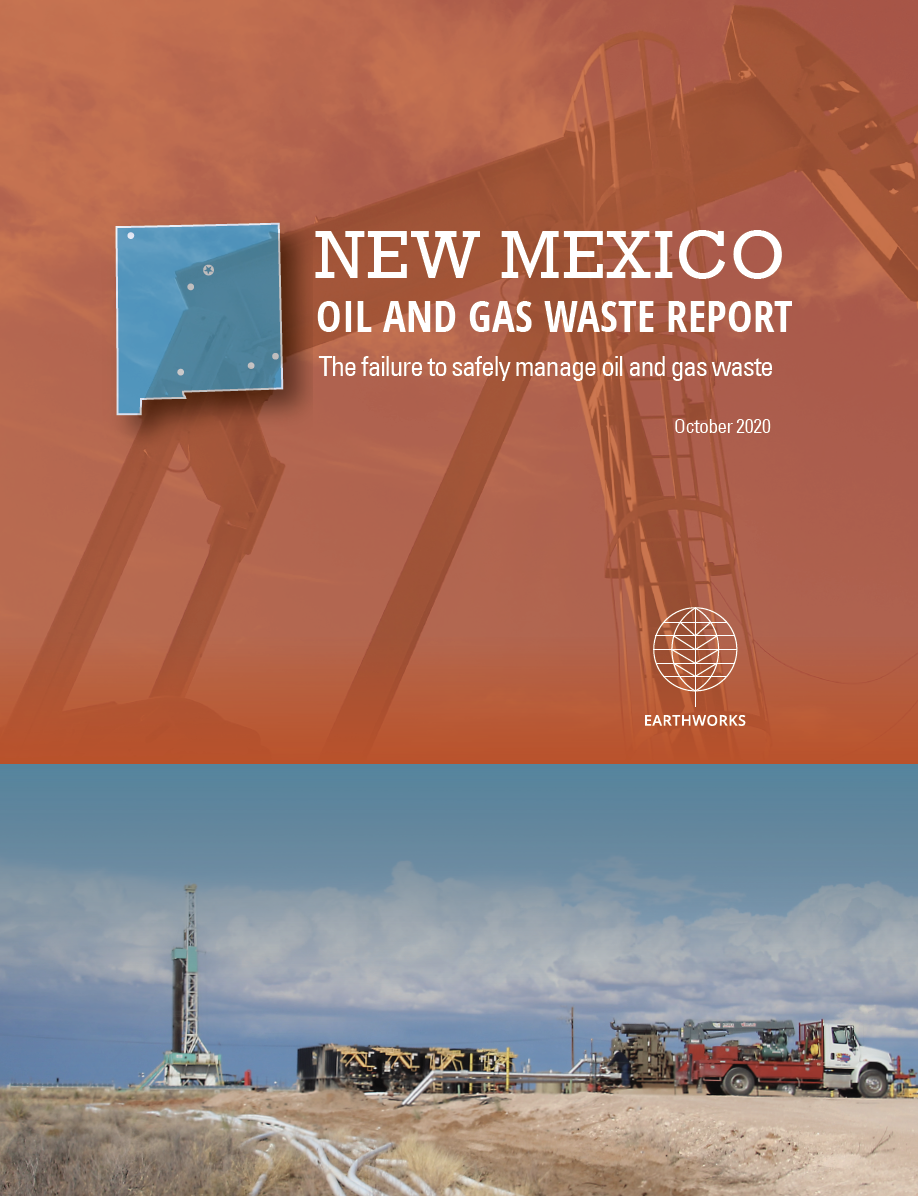The first commercial oil well in New Mexico was drilled in 1922 in Diné territory in the northwest corner of the state, in what is now the Navajo Nation.1 Five years later, the first well was drilled in the Permian Basin in the southeast corner of the state, where a recent oil and gas boom has helped New Mexico become the 3rd highest oil-producing state in the nation2 and the 8th highest natural gas producer.3
The cost of so much oil and gas production is heavy. The Permian Basin produces far more waste than actual oil or gas: about 4 to 7 barrels of liquid wastewater are produced for every single barrel of oil.4 The toxic wastewater is extremely saline and contains known and unknown toxic chemicals, heavy metals, and radioactive materials. Research has found significant health issues associated with oil and gas development, including respiratory conditions such as asthma, cardiovascular concerns such as heart attacks, adverse birth outcomes, mental health conditions, insomnia, and other acute health effects.5
New Mexico continues to expand oil and gas production — 1,905 new drilling permits were issued in 2019 alone. But the state permits these operations in ways that damage the environment and expose industry workers and the public to harmful toxins through improper handling of oil and gas waste. This report outlines the risks posed by the status quo in New Mexico and calls for specific policy changes in order to fully protect land, water, and the public. Recommendations include new standards for testing, tracking, disposal, and remediation of fracking waste to better protect the environment and human health.
Background
New Mexico had 50,613 producing oil and gas wells as of February 2020.6 The Permian Basin, which extends beneath both Texas and New Mexico, is the source of most of New Mexico’s oil production. The San Juan Basin, which extends beneath Colorado and New Mexico, is the primary source of New Mexico’s natural gas production. All this production means not only more oil and gas, but also more environmental damage – from climate-disrupting methane emissions to an increasing number of toxic wastewater releases and more.
Each well produces dangerous waste streams that must be properly managed during the entire lifetime of each well – but none of them are. For example, in 2019, more than 50 billion gallons of liquid waste, euphemistically named “produced water” by the oil and gas industry, were generated in New Mexico.7 In addition, more than 1.4 million gallons of produced wastewater have ended up running over the surface of the earth from 327 spills in the first eight months of 2020 alone.8 The total volume spilled would cover 4.4 acres with one foot of liquid oil and gas toxic wastewater. When it comes to solid waste, unfortunately, there are no public estimates for the volume generated by the oil and gas industry in New Mexico.
The policy changes recommended at the end of this report would help better manage oil and gas waste streams if implemented through support from the public, elected officials, and the oil and gas workers who are exposed to these wastes every day.
The toxic nature of oil and gas waste poses risks to the environment, worker safety, and public health that are exacerbated by the current regulatory landscape in New Mexico.
- First New Mexico Oil Wells, American Oil & Gas Historical Society, June 8, 2020, available at: https://aoghs.org/petroleum-pioneers/hobbs-new-mexico-oil-discovery
- U.S. Energy Information Administration, “Crude Oil Production,” available at: https://www.eia.gov/dnav/pet/pet_crd_ crpdn_adc_mbbl_m.htm
- U.S. Energy Information Administration, “Natural Gas Gross Withdrawals and Production,” available at: https://www.eia. gov/dnav/ng/ng_prod_sum_a_EPG0_FGW_mmcf_m.htm
- New Mexico Environment Department, “Produced Water Management in New Mexico,” October 30, 2019, available at: https://www.env.nm.gov/new-mexico-produced-water/ wp-content/uploads/sites/16/2019/10/Produced-Water-Public-Meeting-Presentation_ENGLISH_Final-191030.pdf
- Shonkoff, Seth, Testimony before the House Subcommittee on Energy and Mineral Resources, July 16, 2019, available at: https://www.psehealthyenergy.org/wp-content/ uploads/2019/07/WRITTEN_Congressional-Testimony_ Shonkoff_FINAL.pdf
- New Mexico Oil Conservation Division, OCD Well Statistics, February 3, 2020, available at: http://www.emnrd.state.nm.us/ OCD/statistics.html
- Oil and gas monthly production data downloaded to Excel spreadsheet from http://www.emnrd.state.nm.us/OCD/statistics.html
-
2020 produced water spills Excel spreadsheet downloaded from http://www.emnrd.state.nm.us/OCD/statistics.html


